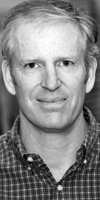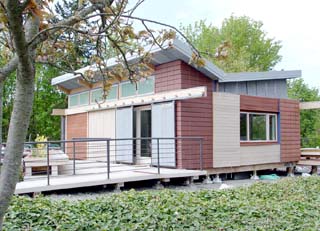|
Subscribe / Renew |
|
|
Contact Us |
|
| ► Subscribe to our Free Weekly Newsletter | |
| home | Welcome, sign in or click here to subscribe. | login |
Environment
| |
October 14, 2008
WSU's Institute for Sustainable Design takes off
Journal Staff Reporter
Washington State University recently launched its Institute for Sustainable Design with the help of $500,000 from the Weyerhaeuser Company Foundation.
Michael Wolcott is director of the institute and will be leading it through its first critical years. He is the Louisiana-Pacific Distinguished Professor of Wood Materials and Engineering, and has spent more than a decade developing renewable building materials for the U.S. Navy, while at WSU.
Q. What is the institute going to do?
A. The basic tenet is to approach work on sustainable design from a very integrated basis. That's really the way it works in the real world if you go to any architectural group working in the area of sustainable design. Most of these designs take place integrated across disciplines right in from the beginning and our education system is not necessarily set up like that. Instead, we educate largely within our specialties. The challenge that we have then is to transform our tried and true traditional education programs over towards this more integrated approach and find appropriate levels to do that.
Q. What is your history with sustainable design?

A. I've been at WSU for 13 years. My academic track record has really been in terms of producing renewable materials. My individual background has really been in the material development piece of green building. The sustainability design movement is really moving towards a more integrated and multi-disciplinary approach. During my material development work, I ran a number of very large programs that involved a number of industries…. It's kind of given me a tool set.
Q. Where did the idea for the institute for sustainable design come from?
A. It started from a grassroots basis. I had been running projects for the U.S. Navy. We were developing new materials to go into marine environments. We were sort of spanning the development of materials and structural applications of these materials and a number of us got tired of pumping things out the exterior and we wanted to work in a more creative way. So we teamed up in sort of ad hoc basis with some of our architecture colleagues and started running projects.
It's really kind of a neat way that this has developed because system design really is integrated design and people have to work together right from the start and that was sort of how we started, not intentionally, but right from the outset. It grew from architecture and engineering and civil engineering management to exploring this new space and working with students. After doing that for a number of years we had enough synergy and energy around the whole thing that we decided to expand it.
Q. What projects did you work on?
The first one was a storage facility out at our laboratory. It was a great opportunity to explore some different thoughts on how we might build more sustainable buildings. Then we entered a competition with the Solar Decathlon home competition, sponsored by the Department of Energy. It's a challenge to develop a net zero building.
Q. How is the institute going to work and how many professors are involved?
A. We're not going to be a physical entity and uproot people from their departments. It will be a virtual structure that allows people to work in their disciplines and partner in the institute. I think there are roughly 20 to 30 faculty that will be interacting with us initially.
Q. What disciplines will benefit from the institute and its new programs?
A. The core group involves architects, landscape architects and interior design, and then civil engineering. And then lastly, the construction component of this in construction management where you get into estimating and costing. But that is a core group. There are many disciplines that will interact on an ad hoc basis as we take on bigger and larger challenges. The next challenge with this is to build it into our other parts... things that aren't so well connected but things like public policy and public health.
Q. Why expand the institute beyond traditional building professions?
A. That's important because the building itself covers one piece of sustainability but what it doesn't handle necessarily is the impact of the building on the larger site. We're trying to reach out past simply the footprint of the building, then it becomes a much larger network of folks that would be interacting on another level. So when you move from just green building to sustainability, you really need to involve a much larger group of professions.
Q. Why is it important for WSU to train students in sustainability?
A. What we feel is that sustainability is being dealt out in practice today right now and it's our job to start to interact with that and help provide opportunities that move forward by providing critical pieces of knowledge as well as students that have a comprehensive knowledge when they leave.
Q. You recently took a sabbatical where you spoke with firms about the program. What did they say they needed?
A. One of the big strategic points we were looking at is... do we start a whole new major or do we produce a civil engineer or mechanical engineer or construction manager or architect that has a specialty or special training in sustainability and uniformly, it was the later. They said, ‘If you create a sustainable engineer, we wouldn't know what to do with them.' What's happening for a lot of firms is sustainability is being built into almost everything they do. We realized we needed to ignite a common knowledge base that was built into all of our degree programs with the built environment.
Q. What has the institute done so far?
A. Green building standards that are used today, they have a certain set of protocols and concepts. So it was crucial to be able to get those types of standards and codes in the knowledge base of the students going forward. We've implemented, with a new hire, two engineering courses that handle the site issues and the building issues and push towards green building standards. When the students take these two courses they would have the knowledge base to test into a LEED accreditation. What we need to do is get the lexicon in the students' mind very early on. And renew it to help them understand what is special and unique. Next year we'll be implementing this cornerstone program, which is the yearlong integrated design concept.
Q. Are students interested in these ideas?
A. Its' unbelievable. It's overwhelming. We recently launched the chapter of Emerging Green Builders, a student chapter for the U.S. Green Building Council… and we had 150 students the first night. We had to up the limits for (the sustainability) courses two times. There is such a pent up desire for this in this generation it's really astounding.
Q. What is one of your goals for the program?
A. One of the things that we've been talking about with the design community is to throw out a challenge towards developing a large demonstration project that would be a neighborhood. We could integrate this course with firms that can actually implement some of this and we can explore new areas of sustainability and really push the envelope on what could be done; that's our eventual goal.
Q. You've said the design community lacks specific design goals. Why are they important?
A. What happens is we design in ways that push us in the right direction, but we can't put a quantifiable metric on what that is. We lack strict design goals. We have tenets and best practices, but we're not designing to a specific level of CO2 emissions. These design goals are important because we can design for a very specific goal to absolutely achieve those goals, rather than maybe achieve those goals.
Q. What is public policy's role in the area of sustainability and the built environment?
A. My opinion is that public policy's role is to set those goals for us as a design community to design to. And without those public policies being set, it's going to be set in a rather ad hoc manner by the owners, by specific communities or by the designers themselves and what they can sell.
Katie Zemtseff can be
reached by email or by phone
at (206) 622-8272.



